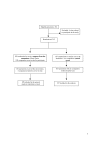Support to woman by a companion of her choice during childbirth: a randomized controlled trial
- PMID: 17612408
- PMCID: PMC1936417
- DOI: 10.1186/1742-4755-4-5
Support to woman by a companion of her choice during childbirth: a randomized controlled trial
Abstract
Background: To evaluate the effectiveness and safety of the support given to women by a companion of their choice during labor and delivery.
Methods: A total of 212 primiparous women were enrolled in a randomized controlled clinical trial carried out between February 2004 and March 2005. One hundred and five women were allocated to the group in which support was permitted and 107 to the group in which there was no support. Variables regarding patient satisfaction and events related to obstetrical care, neonatal results and breastfeeding were evaluated. Student's t-test or Wilcoxon's test, chi-square or Fisher's exact test, risk ratios, and their respective 95% confidence intervals were used in the statistical analysis.
Results: Overall, the women in the support group were more satisfied with labor (median 88.0 versus 76.0, p < 0.0001) and delivery (median 91.4 versus 77.1, p < 0.0001). During labor, patient satisfaction was associated with the presence of a companion (RR 8.06; 95%CI: 4.84 - 13.43), with care received (RR 1.11; 95%CI: 1.01 - 1.22) and with medical guidance (RR 1.14 95%CI: 1.01 - 1.28). During delivery, satisfaction was associated with having a companion (RR 5.57, 95%CI: 3.70 - 8.38), with care received (RR 1.11 95%CI: 1.01 - 1.22) and with vaginal delivery (RR 1.33 95%CI:1.02 - 1.74). The only factor that was significantly lower in the support group was the occurrence of meconium-stained amniotic fluid (RR 0.51; 95%CI: 0.28 - 0.94). There was no statistically significant difference between the two groups with respect to any of the other variables.
Conclusion: The presence of a companion of the woman's choice had a positive influence on her satisfaction with the birth process and did not interfere with other events and interventions, with neonatal outcome or breastfeeding.
Figures
References
-
- Arulkumaran S, Symonds IM. Psychosocial support or active management of labour or both to improve the outcomes of labour. Br J Obstet Gynaecol. 1999;106:617–9. - PubMed
-
- Enkin M, Keirse MJ, Neilson JP, Crowther C, Duley L, Hodnett E, Hofmeyer J. A guide to effective care in pregnancy and childbirth. 3. New York: Oxford University Press; 2000. - PubMed
-
- Hodnett ED, Gates S, Hofmeyr GJ, Sakala C. The Cochrane Library. Oxford: Update Software; 2003. Continuous support for women during childbirth (Cochrane Review) p. CD003766. - PubMed
-
- World Health Organization . Care in normal birth: a practical guide (Maternal and Newborn Health/Safe Motherhood Unit) Geneva: WHO; 1996.
LinkOut - more resources
Full Text Sources


